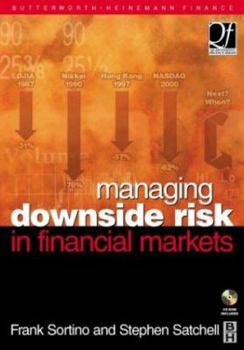Managing Downside Risk in Financial Markets (Quantitative Finance)
Quantitative methods have revolutionized the area of trading, regulation, risk management, portfolio construction, asset pricing and treasury activities, and governmental activity such as central banking to name but some of the applications. Downside-risk, as a quantitative method, is an accurate measurement of investment risk, because it captures the risk of not accomplishing the investor's goal.'Downside Risk in Financial Markets' demonstrates how downside-risk can produce better results in performance measurement and asset allocation than variance modelling. Theory, as well as the practical issues involved in its implementation, is covered and the arguments put forward emphatically show the superiority of downside risk models to variance models in terms of risk measurement and decision making. Variance considers all uncertainty to be risky. Downside-risk only considers returns below that needed to accomplish the investor's goal, to be risky.Risk is one of the biggest issues facing the financial markets today. 'Downside Risk in Financial Markets' outlines the major issues for Investment Managers and focuses on "downside-risk" as a key activity in managing risk in investment/portfolio management. Managing risk is now THE paramount topic within the financial sector and recurring losses through the 1990s has shocked financial institutions into placing much greater emphasis on risk management and control.Free Software Enclosed To help you implement the knowledge you will gain from reading this book, a CD is enclosed that contains free software programs that were previously only available to institutional investors under special licensing agreement to The pension Research Institute. This is our contribution to the advancement of professionalism in portfolio management.The Forsey-Sortino model is an executable program that:1. Runs on any PC without the need of any additional software.2. Uses the bootstrap procedure developed by Dr. Bradley Effron at Stanford University to uncover what could have happened, instead of relying only on what did happen in the past. This is the best procedure we know of for describing the nature of uncertainty in financial markets. 3. Fits a three parameter lognormal distribution to the bootstrapped data to allow downside risk to be calculated from a continuous distribution. This improves the efficacy of the downside risk estimates.4. Calculates upside potential and downside risk from monthly returns on any portfolio manager. 5. Calculates upside potential and downside risk from any user defined distribution.Forsey-Sortino Source Code:1. The source code, written in Visual Basic 5.0, is provided for institutional investors who want to add these calculations to their existing financial services. 2. No royalties are required for this source code, providing institutions inform clients of the source of these calculations. A growing number of services are now calculating downside risk in a manner that we are not comfortable with. Therefore, we want investors to know when downside risk and upside potential are calculated in accordance with the methodology described in this book. Riddles Spreadsheet:1. Neil Riddles, former Senior Vice President and Director of Performance Analysis at Templeton Global Advisors, now COO at Hansberger Global Advisors Inc., offers a free spreadsheet in excel format.2. The spreadsheet calculates downside risk and upside potential relative to the returns on an index
Format:Hardcover
Language:English
ISBN:0750648635
ISBN13:9780750648639
Release Date:October 2001
Publisher:Butterworth-Heinemann
Length:272 Pages
Weight:1.45 lbs.
Dimensions:9.5" x 1.0" x 6.5"
Customer Reviews
1 rating
Excellent Treatment of Risk/Return - A Must Read
Published by Thriftbooks.com User , 22 years ago
Though the book is quite pricey, it delivers a wealth of information regarding various treatments of risk and return. This is not the stuff you find in most financial texts, such as outdated modern portfolio theory. In fact, the material is far beyond the old risk/return traditions of yore. Various authors each contribute a chapter including Sortino so one gets a wide range of views (I only found a few chapters irrelevant to my needs). However, the common theme throughout is, "It is high time to view risk/return in a more meaningful and practical light."This text is not just for portfolio managers. Anyone involved in risk/return assessment will benefit from the material; though much of the book is intended for those with a mathematical slant. The material can easily be applied to discounted cash flow (DCF) financial modeling though this is not discussed in the text. In my opinion, it blows away VAR, Real Options, etc. If you ever thought T-Bills were riskless assts, you need to read this book or be forever wrong. I also found a wealth of information on Sortino's website that complimented the text. Lastly, each chapter is chocked full of nice reference articles for those desiring to delve deeper into the multitude of ideas presented.





